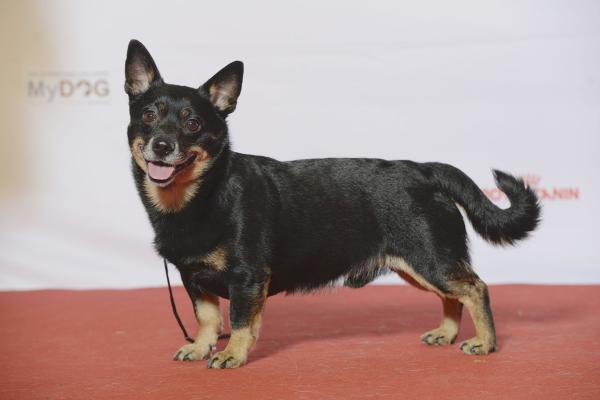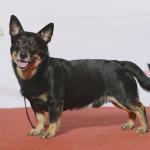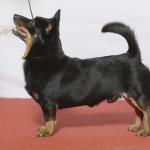Lancashire Heeler

Don't let their size fool you, the Lancashire Heeler is one big ball of energy. Known in the past for being herd and cattle dogs, they are extremely active and intelligent, which makes them a great companion for a family with children that love to take long walks and runs to spend time together. This British breed may not be very well-known, but their loving and affectionate character makes this dog unique. If you are thinking about adopting a Lancashire Heeler, we advise you to take a look at this fact sheet in order to learn everything you should know about the Lancashire Heeler, including their physical and psychological characteristics, their history and proper care, so you can welcome them in a suitable environment.
- Europe
- United Kingdom
- Group I
- 5-14
- 14-18
- 18-22
- 22-27
- 27-31
- More than 31
- 2-7
- 7-22
- 22-55
- 55-100
- 100-220
- 8-10
- 10-12
- 12-14
- 15-20
- Low
- Meidum
- High
Origin of the Lancashire Heeler
Although the actual origin of the Lancashire Heeler is uncertain, the most accepted theory, according to the FCI[1] is that, back in the XIXth century, Welsh Corgis that herded cattle from Wales to the area of Ormskirk in West Lancashire, where it was mated with the Manchester Terrier, thus creating the Ormskirk Terrier or Lancashire Heeler.
Since then, this dog breed was bred for generations and used as a cattle herder due to the fact that they were the perfect size to nib on the cattle's calves. Moreover, they were also used for hunting, especially in burrows to catch rabbits or rats.
Breeding has continued throughout the years, and the Lanchashire Heeler breed standard was accepted by the Kennel Club in 1981. Nowadays, there are only around 7,000 registered Lanchashire Heeler dogs around the World, which is why it was declared a vulnerable native breed in 2006. They are currently also being used as assistant dogs for people with disabilities.
Physical traits of the Lancashire Heeler
As mentioned above, the Kennel Club approved the standards of the Lancashire Heeler breed. Their main physical traits are their short, muscular legs of approximately 1 inch longer in height than the withers. They are sturdy built, with a tail that is set on high and has a slight curve when they are alert. According to FCI standards, their height at the withers should be around 30 cm (11.8 in) in males and 25 cm (9.8 in) in females.
Their head is proportionate to the body in size, with eyes that are round and set apart, a black or brown nose according to the color of their coat, firm lips and erect ears when they are alert, although they can also present tipped ears.
Their fur is short, coarse and shiny, with a fine undercoat that protects them from adverse weather conditions. Lancashire Heelers are usually bi-colored with tan spots on muzzle, inside their hind legs, under their tail and above their eyes. The Kennel Club distinguishes two colors in this breed:
- Black and tan
- Liver and tan with pigment
Character of the Lancashire Heeler
In general, Lancashire Heelers are loving dogs, which are eager to please, which is why they show a very affectionate character with their owners. They are cheerful and happy, even to the point that, according to the AKC, this breed has been known to draw their lips back in order to emulate a smile when they are content. Being a shepherd dog, they are highly intelligent, courageous and highly energetic, thus needing plenty of play time with their carers. They can also be pretty mischievous and stubborn, which is why they will need an experienced dog owner that is firm with them and knows how to handle them both with affection and consistency.
If trained and socialized correctly, a Lancashire Heeler should be both friendly with strangers and other dogs, but have a tendency to be pretty shy and mischievous which is why proper socialization is highly important for this breed. However, you should know that their intelligence means that they can learn very quickly and have a low tendency to bark and bite. Their intelligence and stubbornness also makes them great escapees, which is why controlling them in enclosed open-air spaces where there is no possibility to flee is an advisable option.
Lancashire Heeler care
Apart from the regular care any dog needs to be well looked after, including their regular vaccinations and deworming schedule, it is important to know some of the specifics to make your Lancashire Heeler happy.
It is advisable to take your dog for long walks in places where they can run around at their will, as long as they don't have any escape places due to their instincts mentioned above. This is especially important if your dog lives in an apartment, as they will need to get rid of all their energy if you want to avoid them being overweight, avoiding boredom in the dog and preventing misbehavior. Remember that this breed needs hour long walks daily in order to be content and around a distance of 8 miles per week on average.
Brushing their fur with a firm short bristle brush is recommended once a month maximum. Their short hair means there is no need to bathe them unless they have got specifically dirty or twice a year. When drying your dog, it's important to make sure no moist is left in the undercoat or it could create fungal infections, which is why they need to be dried thoroughly.
It is important to feed your Lancashire Heeler with dry feed and limit the amount of human food and treats you give them due to possible mineral imbalances which could affect their bones and teeth and could boost chances of obesity in this breed.
Lancashire Heeler education
Due to their stubbornness, it's very important to start training and socialization at a very young age. A Lancashire Heeler will learn quickly, but it's important to be persistent when teaching your dog basic commands so they do not misbehave in the future.
Due to their herding instincts and intelligence, this is a great breed to go one step further to teach them more complicated tricks and even start doing agility, a great activity you and your pet can do together in order to create an even stronger bond. They are also great if you want to take part in herding events and are even great to practice flyball, which will be great exercise for them. Remember that all their education is best done through positive reinforcement, which is not only beneficial to form their loving character, but will help them learn even quicker.
These are not dogs that like to be left alone for long periods of time, which is why it's recommended to use puzzle games or kongs to stimulate their brain activity.
Lancashire Heeler Health
Lancashire heelers have a pretty good lifespan, of approximately twelve to fifteen years. However, due to inbreeding, this breed tends to have certain inherited problems, especially in the eye area. Here are the most common health problems that Lancashire heelers can present:
Cataracts
This is usually a hereditary condition that can form at an early age and appears in dogs under the age of five. Due to the fact that this is not the same as cataracts in elderly dogs, this condition needs careful monitoring so it does not aggravate.
Lens luxation
This inherited condition can lead to blindness in Lancashire Heelers. It is characterized by a breakage of the fibers that hold the dog's eye lens in place, which can lead to blindness or glaucoma. This condition can be treated if detected in time, which is why it's highly important to check your dog's eyes as they get older.
Collie eye anomaly
Lancashire Heelers can be born with this condition that can create several other conditions in your dog's eye which include choroidal hypoplasia, coloboma or retinal detachment.
Pestistent pupillary membranes
This is an ailment that can appear in puppies aged from six to ten months. You will notice that a layer or cobweb appears in the dog's eyes, which are pieces of blood vessels that got attached to the dog's eyes while in the womb. However, this condition does not produce the dog any pain.
Patellar luxation
Due to their short legs, they are prone to the breakage of the floating patella or floating kneecap through dislocation. This can lead to degenerative arthritis and problems in the dog's motor activity. However, it is only recommended to be treated in very severe cases.
In order to prevent these problems, it's highly important to take your pet to bi-anual veterinary check ups and make sure eye examination is thorough.
Lancashire Heeler photos










 I am an old Vietnam vetean and at age 79 I had a heart attack followed by a stroke and now I have a Pacemaker. I am not familiar with the Lancashire terrier but, I like the way he is built. Nor do i know how expensive they are. I have been a dog lover all my life and I used to breed Dachshunds. Now I am all alone, don't nav9gate to well and I believe that having a dog would be a blessing for me.
I am an old Vietnam vetean and at age 79 I had a heart attack followed by a stroke and now I have a Pacemaker. I am not familiar with the Lancashire terrier but, I like the way he is built. Nor do i know how expensive they are. I have been a dog lover all my life and I used to breed Dachshunds. Now I am all alone, don't nav9gate to well and I believe that having a dog would be a blessing for me.




